History of the Bus Transport
In the year 1841 Olomouc got a railway connection with Vienna. For years later the railway was extended to Prague and that time První olomoucká omnibusová společnost opened its activities that provided a connection between the town and a remote railway station. The omnibuses are considered to be a cornerstone of the history of the mass transport without tracks in Olomouc and an augury of the later bus transport.
Horse omnibuses were 1899 replaced by modern tramcars. In the following decades the mass transport took place only on the tracks. After establishment of a new administrative board, so-called Great Olomouc, 13 communities were connected to the town Olomouc according to the law No. 214/1919 Sb. The tramcar network of six kilometres was insufficient for service of the area with an area of approx. 4 000 hectares and 57 thousand of citizens. 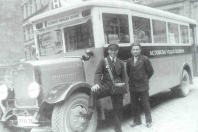
After the end of the World War I the town had not enough of means for development of the metropolitan railway and there was the highest time for establishing town buses, although at this time the buses were rather rare means of transports. The nearest town bus lines were in Jablonec nad Nisou and Prague at the end of 1926.
Olomouc became 1927 the first town in Moravia, which has its own bus transport.
December 30, 1926
The first official step that precedes to establishing a town bus transport in Olomouc. The town council of Olomouc decided to ask for an issue of a licence for three bus routes in cadastral district of the town. This day trial runs of the buses were started through the streets of Olomouc. Six days later the application was extended to the tracks exceeding the town cadastre.
February 7, 1927
The town board of representatives gave the operation of the bus transport to the entrepreneur Rudolf Synovec from Olomouc, namely on the following routes: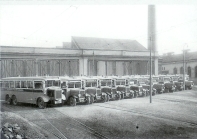
- The Masarykovo (Upper ) Square - Pavlovičky - Chválkovice (3 times daily to Svatý Kopeček) and back
- The Masarykovo Square - Nový Svět - Holice - Hodolany – Main Station – The Masarykovo Square
- The Masarykovo Square - Hejčín - Řepčín - Křelov - Břuchotín and back and the Masarykovo square - Nové Sady and back
One bus was used for each line, the fourth served as a stand-by one. The vehicle fleet consisted of one Praga AN, apparently with eight sitting places and three Škoda 505 with sixteen sitting places and eight standing places. The bus transport was enlarged with further lines in course of the time and till 1930 all directions were serviced.
January 1, 1933
The town bus transport was handed over to the enterprise Elektrické podniky hlavního města Olomouce. Since this time a common transport company run the tram and bus transports. The buses were signed with a new company marking: AUTODRÁHA E. P. OLOMOUC. Since the date the buses were stored in garages built from the former engine room of the power plant in the building of the tramcar car shed.
October 2, 1933
The enterprise Elektrické podniky hlavního města Olomouce got a licence for chartered coach transport.
November 1, 1933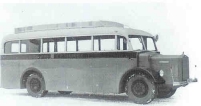 Elektrické podniky started to run the first bus, which was equipped with an alternative drive – wood gas generator from the company of Rudolf Synovec. The trend of the transfer for an alternative drive continued for the whole thirties od the 20th century. During the World War II these adjustments were completed with a reconstruction of the remaining petrol drives to lighting gas.
Elektrické podniky started to run the first bus, which was equipped with an alternative drive – wood gas generator from the company of Rudolf Synovec. The trend of the transfer for an alternative drive continued for the whole thirties od the 20th century. During the World War II these adjustments were completed with a reconstruction of the remaining petrol drives to lighting gas.
1936
The town bus Škoda 505 was reconstructed for the chartered coach transport and the pilot ship of the bus transport of Elektrické podniky became a new great three-axle bus Tatra 24/58 with a customized bus body from the body workshop Bohemia in Česká Lípa..
March 1939
A very fast change-over to right direction working. The buses had the door only on the left side of the bus body and in comparison with the other cars and usual both directions tramcars it was a great intervention into the vehicle design.
1943
The first three towing cars were bought. Their number was enhanced till the end of the World War II to five.
1945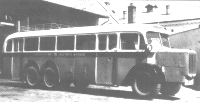 At the beginning of the year only 16 buses from the whole number of 23 remained in operation, however this amount decreased in course of the year. The buses were put out of the operation because of the shortage of fuel, tyres and spare parts. The drivers simulated failures and the machanicians sabotaged repairs and maintenance of the buses, in order to decrease the number of the buses in running to minimum and to protect the most of them against German soldiers. When a fight in Olomouc took place, only one bus was in running and it was used by German in the retreat. The damaged bus arrived only in Litovel, where it stopped and it was returned to Elektrické podniky later.
At the beginning of the year only 16 buses from the whole number of 23 remained in operation, however this amount decreased in course of the year. The buses were put out of the operation because of the shortage of fuel, tyres and spare parts. The drivers simulated failures and the machanicians sabotaged repairs and maintenance of the buses, in order to decrease the number of the buses in running to minimum and to protect the most of them against German soldiers. When a fight in Olomouc took place, only one bus was in running and it was used by German in the retreat. The damaged bus arrived only in Litovel, where it stopped and it was returned to Elektrické podniky later.
October 14, 1945
All power sources were nationalized by means of the decree of the president of the republic No. 100. It affected the town?s power plant and the distribution network. Only the metropolitan railway and the car tracks remain from the existing Elektrické podniky. A new enterprise, Dopravní podniky hlavního města Olomouce, came into being and has remained in the administration of the town.
December 2, 1946
A suburban line "K" to Horka nad Moravou and Chomoutov was established. Becasue of a shortage of the buses in running a truck Tatra 27 was used for this line till 1947.
1947
The first new large buses Škoda 706 RO became an augury of a modernization of the car park.
November 8, 1948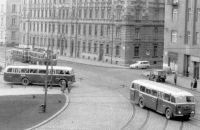 The rooms in garages of the former power plant were insufficient for the growing number of buses. Therefore the courtyard between the tramcar shed and bus garages was roofed. The roofed room for the buses was doubled and it has served after some adjustments till today. A pumping station and further stabling place were established behind the garages in the Dobrovského Street in the place of a covered up bed of the river Moravia.
The rooms in garages of the former power plant were insufficient for the growing number of buses. Therefore the courtyard between the tramcar shed and bus garages was roofed. The roofed room for the buses was doubled and it has served after some adjustments till today. A pumping station and further stabling place were established behind the garages in the Dobrovského Street in the place of a covered up bed of the river Moravia.
1952
A change in marking of lines. The existing marking A till K was replaced by the numbers 11 till 18. The auxiliary buses were marked with X.
1957
The last buses of the first generation were put out of operation (Praga RN, Škoda 606 GN, Tatra 27/64D and Tatra 24/58 – the latest "Tatra Cars" were respectably 19 years old). For a short time, only the buses Škoda 706 RO with six delivery tracks ruled over the streets of Olomouc. They were manufactured during the war and 1951 they were supplied with three buses of the type D4.
March 1959
The first bus Škoda 706 RTO was bought. In turn, 54 buses of this type were used in the service of Dopravní podnik města Olomouce.
1961
The main bus centre of town buses was moved from the central square, called the Míru Square, to the neighbouring Rudé Square after 34 years (now the Down Square).
October 1, 1962 The conductors stopped to be in service in the bus line No. 13 and a self-service was introduced. The passengers put the coins into the cash desk at the driver. This kind of service was enlarged and in the sixties the service with conductors was cancelled in turn.
The conductors stopped to be in service in the bus line No. 13 and a self-service was introduced. The passengers put the coins into the cash desk at the driver. This kind of service was enlarged and in the sixties the service with conductors was cancelled in turn.
July 1, 1967
A new changing place in the centre of the town became the Národních hrdinů Square, where all tramcar lines were available. The bus operation has been led outside the narrow streets of the historical centre of the town since that time.
Also a non-changing tariff was introduced and the night tramcar transport was replaced by a bus transport.
1968
The 23 out-of-date buses Škoda 706 RO were put out of operation from the streets of Olomouc. The second period of a fully unified car park of vehicles started.
1969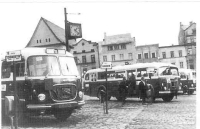 A unique car park of buses of the type Škoda 706 RTO was supplied with the first buses of the type ŠM 11. A quite new feature was its fully automatized gear box which saved labour for the drivers in the rush town traffic. A roomy bus body with a three door arrangement with air suspension contributed to improving of the travelling culture.
A unique car park of buses of the type Škoda 706 RTO was supplied with the first buses of the type ŠM 11. A quite new feature was its fully automatized gear box which saved labour for the drivers in the rush town traffic. A roomy bus body with a three door arrangement with air suspension contributed to improving of the travelling culture.
December 1971
A trial run of the stabling place for buses in the Dolní Hejčínská Street near the former stadium Spartakiádní was opened. The stabling place has been used since its approval on November 8, 1972..
1975
The last bus trailers were put out of operation in this year. A capacity replacement for the bus with a trailer was missing for the further 4 years in the town traffic of Olomouc. This deficiency was removed by the first joint buses.
June 12, 1978
Olomouc exceeded the limit of 100.000 citizens and it became a large town. This was achieved by natural growth of the number of citizens and an integration of the surrounding communities. A connection by means of the urban transport instead of former ČSAD lines was introduced into new integrated communities, namely 1976 to Nedvězí and 1978 to Topolany, Křelov and Břuchotín.
1979
The most Škoda 706 RTO buses were put out of operation and the remaining ones were stabled as the stand-by ones. Moreover, this year the first two joint buses Ikarus 280 were delivered.
October 31, 1981
The night bus transport was stopped and it was replaced by a night tramcar transport.
1982
The beginning of deliveries of KAROSA B 731 town buses. Later the deliveries of the vehicles were supplied with "suburban" buses of the type B 732 wih a mechanical gear box.
1988
The last "ŠM" were put out of operation from the urban transport. Two years later the last bus of he type ŠD 11 was put out of operation from the chartered coach transport. Altogether 111 buses of the type Š 11 were used in the services of DPMO.
September 30, 1989
The timebooks entered in force. 64 buses from the whole number of 95 vehicles were used in rush hours in the streets of the town. The bus transport achieved its maximum. In further years the influence of individual motoring began to increase and the number of owned as well as rented buses was reduced.
March 18, 1991
The bus of the line No. 26 began to run from Olomouc - Topolany to Hněvotín. The line extending was subsidized by the Municipal Authority and agricultural cooperative, however, it finished at the end of April of this year.
1992
The first KAROSA B 741 joint buses were bought. They were running for the whole decade in this anniversary year in Olomouc.
October 22, 1992
The stabling place in Hejčín stopped to be only a car park for buses. A hall of daily maintenance was established here and the background of bus service was enlarged by a new washing machine for buses. The area was supplied with a fuel pumping station, hall of oil service, diagnostic workshop and tribotechnical laboratory.
December 1, 1993
A bus line for disabled passengers was established. The Karosa B 732 bus was adapted for this line and it was equipped with a lifting platform for entrance and getting out for the disabled people.
May 1, 1994
A changing tariff was introduced after 27 ears. For the first time in the history of the urban mass transport in Olomouc it was possible to change with one ticket between buses and tramcars. The electronic ticket marking devices have been installed into the vehicles. DPMO became the first service of the town mass transport in Moravia that offered a changing tariff to the passengers.
1996
The SOR B 7,5 midibuses with lowered floor levels and hydraulically controlled design that changes a single stair into an angular roll-on ramp were bought. The buses have been used on the line No. 41 - "Barrier" and in May 1996 on the new established line No. 42 connecting the tram stops with the area of he Faculty Hospital in Olomouc.
January 1, 1997
The beginning of the Integrated Transport System od the district of Olomouc (IDOS). The system included the lines of the town mass transport and three suburban lines of ČSAD Ostrava, a. s. In the scope of the integration, the service of Břuchotín, Křelov, Nedvězí and the area near the meat production plant was handed over from DPMO to ČSAD Ostrava, a.s.
July 10, 1997
The most significant passenger travelled in our town bus. The president of the Czech Republic, Mr. Václav Havel, and his suite went from the airport in Neředín to accessible town parts and back, in order to see the results of destructive flood personally.
April 5, 1998
The enlargement of the Integrated Transport System of the district Olomouc. "Blue" ČSAD Ostrava a.s. buses took over the service of the town parts Týneček, Chomoutov and Nový Dvůr from the "red" DPMO buses. The most used bus line being serviced by DPMO became the line 16 connecting the centre of the town with the housing estates in Povel, Nové Sady and Tabulový vrch. According to a town planning scheme a tramcar transport should be introduced into these parts.
October 29, 1998
The board of representatives of the town Olomouc accepted a new town planning scheme. It sustained the tramcar transport as a pilot one and it included its enlargement. The bus transport is considered to be an auxiliary one, however, no without relevance. The concentrated transport streams in the tracmar transport and an enlarged bus transport offer a quality, fast and comfortable transport to the passengers so that the vehicles of the mass transport can compete with individual motoring.
Compiled by:
M.Bureš, Ing. P.Zatloukal
 Dopravní podnik města Olomouce, a.s.
Dopravní podnik města Olomouce, a.s.
Company headquarters
Koželužská 563/1, Olomouc
+420 585 533 111
dpmo@dpmo.cz
Společnost Dopravní podnik města Olomouce, a.s., IČO 47676639, sídlo Koželužská 563/1, 779 00 Olomouc, je členem koncernu statutárního města Olomouc, kde statutární město Olomouc, IČO 002 99 308, se sídlem Horní náměstí 583, 779 11 Olomouc, vystupuje jako řídící osoba.
Copyright © 2025 Dopravní podnik města Olomouce, a.s.
Programming © WINTERNET s.r.o.









